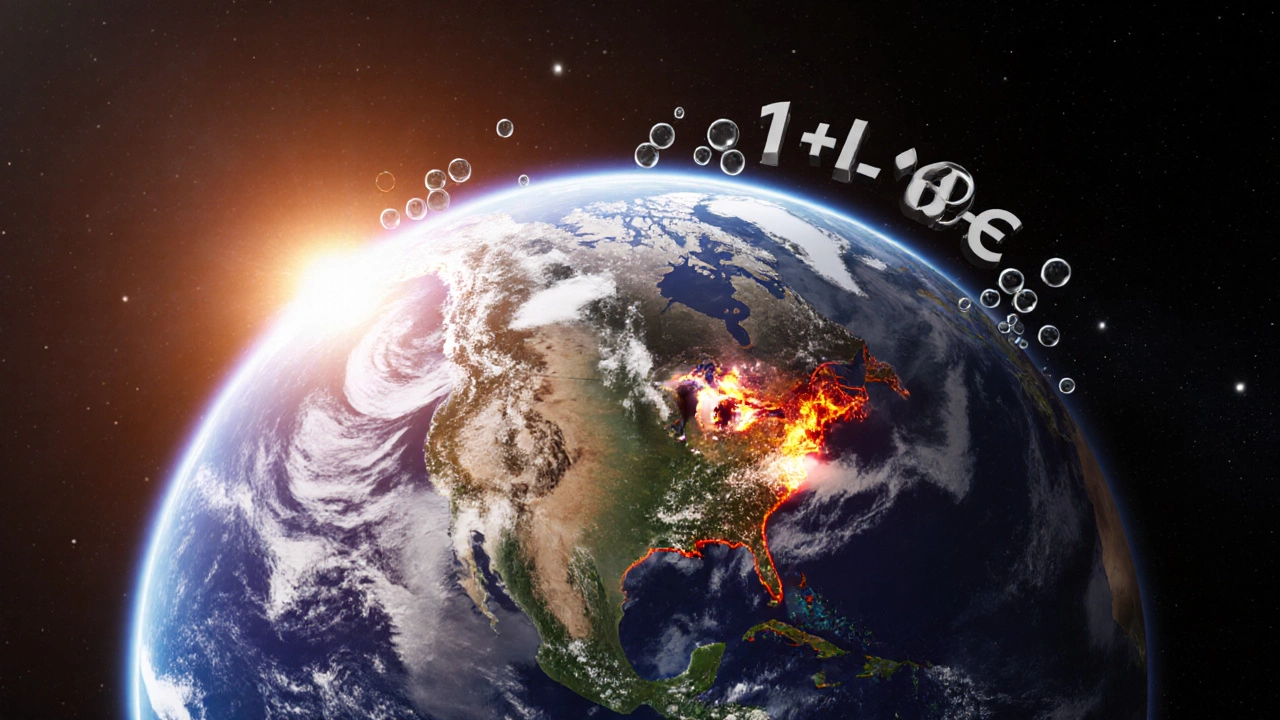2024 Climate Snapshot: What’s Happening to Earth Right Now?
 Oct, 24 2025
Oct, 24 2025
Climate Impact Calculator
Personal Climate Impact Calculator
Calculate your annual carbon footprint based on lifestyle choices. Your results will be compared to the global average and climate targets.
Your Annual Carbon Footprint
How you compare
- Global average footprint 4.7 tonnes
- 2024 global emissions 36 gigatonnes
- 1.5°C target limit 1.5 tonnes
Climate Action Recommendations
Earth is the third planet from the Sun and home to billions of species, but in 2024 its climate system is under unprecedented stress. Scientists, policymakers, and everyday citizens are watching temperature records, ice melt, and weather extremes to gauge how fast the planet is changing.
Key Climate Indicators for 2024
Global surface temperature this year has already surpassed the 2016 benchmark by 0.12 °C, keeping the 5‑year average 1.18 °C above pre‑industrial levels. Carbon dioxide concentrations hit 424 ppm in May, the highest seasonal reading on record.
| Metric | 2024 (to Oct) | 2023 (annual) |
|---|---|---|
| Global Avg. Temp. Anomaly (°C) | +1.18 | +1.16 |
| CO₂ Concentration (ppm) | 424 | 421 |
| Arctic Sea Ice Extent (million km²) | 13.2 (Sept) | 13.8 (Sept) |
| Global Freshwater Drought Area (% land) | 24 | 21 |
| Number of Extreme Heatwave Events | 78 | 65 |
What’s Driving the Numbers?
Global warming 2024 is largely powered by continued fossil‑fuel combustion. Coal use in Asia rose 3 % despite pledges to phase it out, while natural‑gas demand in Europe spiked after the winter energy crunch.
Carbon emissions from industry and transport together contributed roughly 36 gigatonnes of CO₂ in 2024, a modest 0.5 % increase over 2023.
Deforestation remains a major culprit. According to satellite data, the Amazon lost 7,200 km² of forest this year-about the size of Luxembourg-driven by illegal logging and soy expansion.
Melting Ice and Rising Seas
The Arctic is losing ice at an accelerating pace. Arctic sea ice reached its minimum extent in September 2024 that's 2.3 % smaller than the 2000‑2020 average. The Greenland Ice Sheet contributed an additional 0.34 mm to global sea‑level rise this year.
Coastal communities in Bangladesh, the Netherlands, and the U.S. Gulf Coast are already feeling higher tides and more frequent flooding. A recent UN report warned that without rapid emissions cuts, sea levels could rise 0.5 m by 2100, displacing tens of millions.

Extreme Weather on the Rise
Heatwaves are becoming longer and hotter. In June, a historic heat dome over the western United States pushed temperatures above 45 °C in Death Valley for a record‑breaking 12 consecutive days.
Wildfires burned an estimated 11 million hectares worldwide, with Australia’s “Black Summer II” season alone accounting for 3.2 million hectares. Wildfires are fueled by hotter, drier conditions and expanding forest interfaces.
Conversely, severe droughts have crippled agriculture in East Africa, leading to projected cereal production drops of up to 15 % this year.
Policy and Action in 2024
Internationally, the IPCC released its Sixth Assessment Report, stressing that limiting warming to 1.5 °C requires net‑zero emissions by 2050.
The U.S. re‑joined the Paris Agreement in early 2024 and unveiled a $2 trillion Green Infrastructure plan, targeting renewable energy, electric‑vehicle charging, and climate‑resilient housing.
Europe’s “Fit for 55” package moved forward, aiming to cut greenhouse‑gas emissions by 55 % relative to 1990 levels by 2030. Several EU members have pledged to phase out coal entirely by 2035.
Developing nations are receiving increased climate finance through the Green Climate Fund, which disbursed $13 billion in 2024 for adaptation projects ranging from flood defenses in Vietnam to solar micro‑grids in Kenya.

Technological Shifts: Renewable Energy Gains Momentum
Renewable energy hit a new milestone: solar and wind together supplied 38 % of global electricity generation in 2024, up from 34 % in 2023.
Battery storage capacity expanded by 22 % as utility‑scale projects came online in Texas, South Korea, and South Africa, helping smooth out intermittency.
Hydrogen, especially green hydrogen produced via electrolysis powered by renewable electricity, saw its first commercial export from Australia to Japan, marking a potential new low‑carbon fuel pathway.
What Can Individuals Do Right Now?
- Reduce personal carbon footprints by switching to a plant‑based diet for at least three meals a week.
- Upgrade home insulation and install programmable thermostats to cut heating‑related emissions.
- Choose renewable electricity providers where available, or consider rooftop solar installations.
- Support climate‑friendly policies by contacting local representatives and voting in upcoming elections.
- Volunteer with or donate to organizations that focus on reforestation, climate education, or disaster relief.
Looking Ahead: 2025 and Beyond
Scientists warn that the next 12 months are critical. If global CO₂ emissions don’t start declining sharply in 2024, the carbon budget for staying below 1.5 °C could be exhausted within a decade.
Technological breakthroughs-like cost‑effective direct‑air capture and next‑generation nuclear reactors-are being piloted, but scaling them up will take years and significant investment.
For now, the data from 2024 paints a clear picture: the planet is warming, weather extremes are intensifying, and human actions are the primary driver. Turning the tide will require coordinated effort across governments, businesses, and the public.
Why is 2024 considered a pivotal year for climate change?
2024 marks the first year where renewable electricity consistently exceeded 35 % of global generation while global temperature anomalies continue to climb, indicating that mitigation efforts are scaling but not fast enough to curb warming.
What are the most concerning climate impacts observed so far?
Key concerns include record‑low Arctic sea‑ice extent, increasing frequency of extreme heatwaves, expanding wildfires, and rising sea levels that threaten low‑lying coastal populations.
How reliable are the temperature records for 2024?
Temperature data comes from well‑established sources like NASA’s GISTEMP, NOAA’s GlobalTemp, and the European Centre for Medium‑Range Weather Forecasts, all of which use satellite, surface, and ocean measurements to ensure high accuracy.
What role does the IPCC play in shaping 2024 climate policy?
The IPCC provides the scientific foundation for policy decisions. Its 2024 Sixth Assessment Report highlighted the urgent need for net‑zero emissions, influencing national commitments and the EU’s “Fit for 55” legislation.
Can individual actions really make a difference?
Collective individual actions add up. Shifting diets, improving home energy efficiency, and supporting clean‑energy providers collectively reduce demand for fossil fuels and signal market demand for greener solutions.
